Updated 2019-08-25 in time for the ÖTILLÖ Swimrun World Championship 2019. The original article was posted 2018-09-04 right after Worlds 2018.
Yes, together with my teammate Tomas Granberg we finished in under 9 hours in the 2018 perfect conditions. Men’s category 20th place and 27th overall with a time of 8:57.49. But a lengthy post bragging about that wouldn’t be of much use to the world, so let’s leave us aside and instead talk about the strategy that goes into executing at your best potential at ÖTILLÖ Worlds for anyone attempting, be that sub 8, 9 or 10 or whatever.
Obviously the most important thing is training, training and some more training, but today I’ll leave that whole thing out and focus on race execution, which is particularly important at ÖTILLÖ Worlds.
Knowing the course
- If you are not a repeat participant, recon every section with Google Maps or equivalent. The ÖTILLÖ website has an official Google Maps route with stations.
- Some people write a table of distances of all the legs on their paddles. We don’t. Instead we focus on the key takeaways such as those following below, which are not too hard to remember.
- On which island is there no energy station for a long time but still enough time to eat a bar? (Answer: Vånsholmen)
- Where do I need to pick up water or sports drink in a soft flask that I’ve carried with me? (Answer: Ornö church, and more places if very hot conditions)
- Where do I keep my swim cap on and goggles readily on forehead at water exit, because the next swim is just around the corner? (Answer: after the pig swim, after the 1 km swim, on Mellankobbarna but not Järnholmen if hot weather, etc)
- If the weather is warm, where do you peel your wetsuit down? (Answer: probably only at Ornö)
- How long does it take for both teammates to peel the wetsuit down and up again? If it takes a long time, would it be better to accept a little heat and drink a bit more?
- If your team is strong in the off-trail, where do you want to avoid being stuck behind a pack where there is little room for overtaking? You need to know such things.
- You might think that nine or so hours give plenty of time to think but that isn’t really the case with ÖTILLÖ. There are so many micro decisions and focus needs to be on point almost all the time. To me ÖTILLÖ has more intensity and adrenaline than a 10 km race on the road.
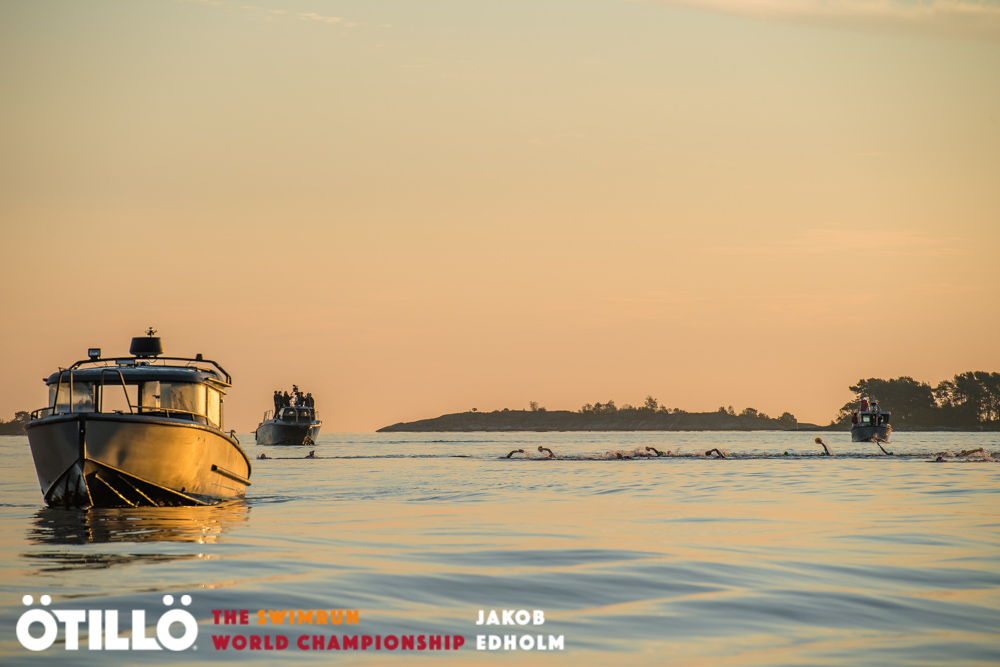
Race-day nutrition
- I consumed about 400 ml of standard gel. You might need to put additional caffeine (400 mg is good for me) and electrolytes (sodium being most important) in there. Carbohydrate supply from stations just won’t be enough. ÖTILLÖ Worlds is similar to an Ironman effort but with a little more heart rate fluctuation.
- I put my gel in a 500 ml soft flask with no risk of littering and no messing around with packaging. Many people find it hard to take solids at the latter part of a race. You probably want to save some gel for the final two hours when even banana feels as too much. Take a sip of gel every 20 min or so when on land. Time just before swim entry to distribute over time. Also, you might want to put the caffeine in the bottom half of your container, to give you that boost at the back half of the race.
- In addition to gel I pack one bar for Vånsholmen and eat banana or equivalent from aid stations as they appear. Adapt to your preference.
- Drink plenty of at the stations. It is difficult to sense dehydration at an early stage. Especially when you are in the cold water. As with gels, keeping count on ingestion is more reliable than “feeling”.
- Provided your stomach allows, drink from the ocean while swimming. You might want to try that during exercise to see what amount your stomach can handle.
- I bring two soft flasks. One, as said, containing my gel mix and one initially empty for liquid picked up at aid stations. Stations do not provide cups as an environmental consideration.
- In case of stomach pain, I choose to back down but it is very important to continue taking gel as soon as the pain subsides.
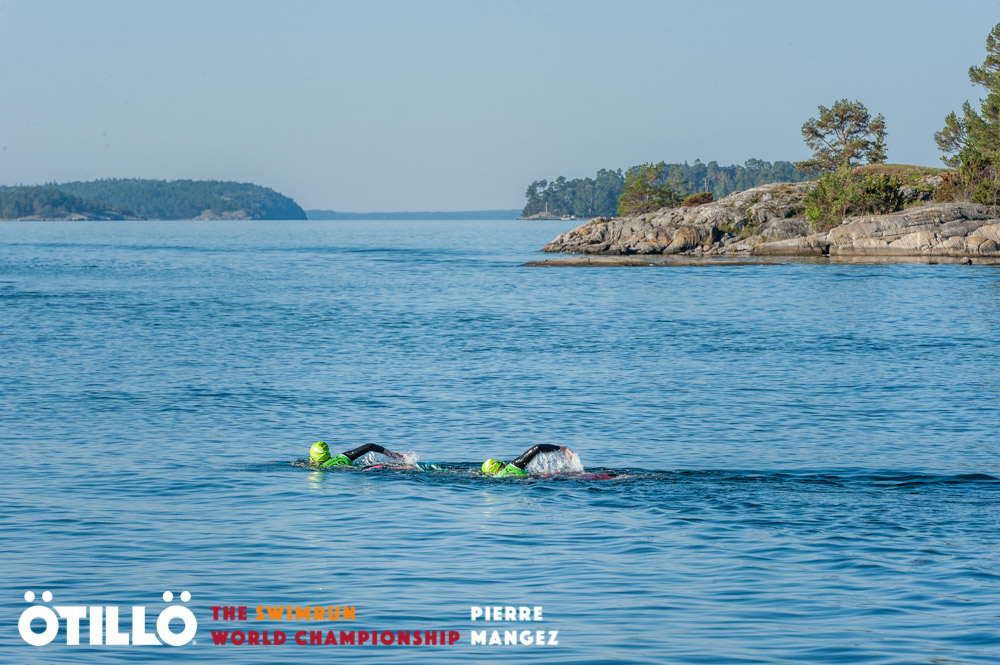
Swims
- You are aiming for beach flags mainly. At the first swim and a latter 1 km swim there is usually a solid strobe light to guide you. Sometimes there are intermediate guidance pyramid buoys. You don’t need to pass them on a specific side.
- Draft whenever the opportunity arises, or even strategically stalk a team at suitable speed from land. You’ll always have your partner draft on you or the other way around, in any case. Side-by-side is wasting your team’s energy total to no use. The men’s front of ÖTILLÖ will usually be a group for a very long time, until a team breaks away on a run. You might realize why.
- Swimming about 10 km in a day with long runs in between means energy efficiency is key. You don’t venture into higher heart rates if there is not a very good reason to do so. Don’t worry, there will be plenty of time at the end for redlining anyway.
- If you realize you gap your partner swimming and you don’t have a tow line, slow your stroke down as to help your partner to get back into draft. When approaching shore, on the other hand, you could swim a few meters ahead allowing for some exit scouting.
- Sighting is very important. Even if you are a good swimmer you don’t want to be swimming 740 m when everyone else is swimming 700. Personally I prioritize sighting and swimming straight over pushing it very hard since my ability to swim straight deteriorates at very high effort. Especially so in choppy water.
- Most teams use fairly big hand paddles but don’t bring paddles so big that you are no longer able to pull through the whole stroke at the back half of the race.
- ÖTILLÖ WC is in the Baltic Ocean, which has brackish water. Some people will go without goggles and that works. If you use stronger contact lenses, you might want to bring a spare contact if swimming without goggles. This also being a thing to definitely practice before adopting.
- You may swim through currents, especially on the swims between Ornö and Utö. Those are the last swim sections of the course when you are the most fatigued. If the water is moving rapidly, counter already before hitting the current to get some slack. Currents may switch directions from one year to the next.
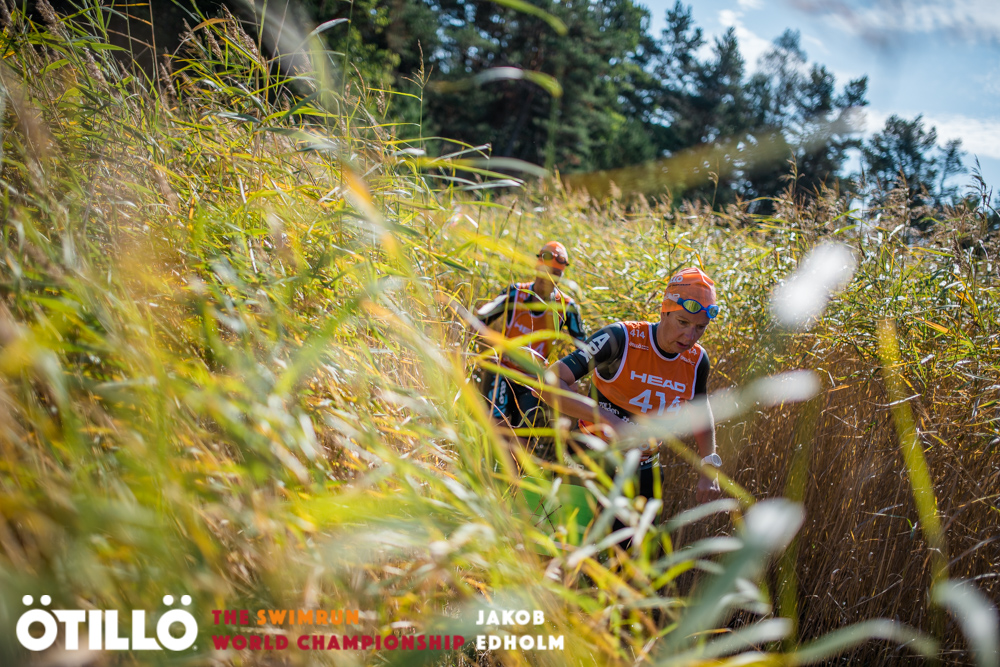
Runs
- The course has everything from tarmac to scrambling. “65 km of running” is more like 35 km of runnable, 25 km of technical trail and 5 km of complete wilderness expedition. ;)
- First-timers will likely be surprised by the amount of off-trail and slippery rock. You need good grip. Especially in a wet year when rain is falling on race day or the days before. Non-spike orienteering shoes are popular with ÖTILLÖ Worlds athletes.
- If one of you is a considerably stronger runner, that person might be pulling with a tow line at the runnable sections. You might prefer pulling a little throughout the whole race instead of one of you bonking two thirds into and the other then trying to pull very hard. Watch out since pulling hard might trigger cramps in the calves.
Pacing
- What pace would you be able to maintain throughout the whole race? Now take that pace and go just a little faster. You don’t want to underachieve. That should still end up being a bit slower than how most teams pace themselves. This applies in general but not always at the men’s front as there are not many teams to draft on the swims so you might factor that in too. There are a lot of micro decisions like that to be taken during the race.
- When I say pacing I mean effort-based and not actual speed since the course is so varied. We just avoid going “red” or even “orange” early on. This has the drawback that you might get stuck behind a crowd since a lot of teams can’t seem to pace themselves so think of strategies to mitigate that.
- Again, remember to pace yourself. As they say at WS100, if you’re in the lead after the first climb, you are probably not going to win the race. :)
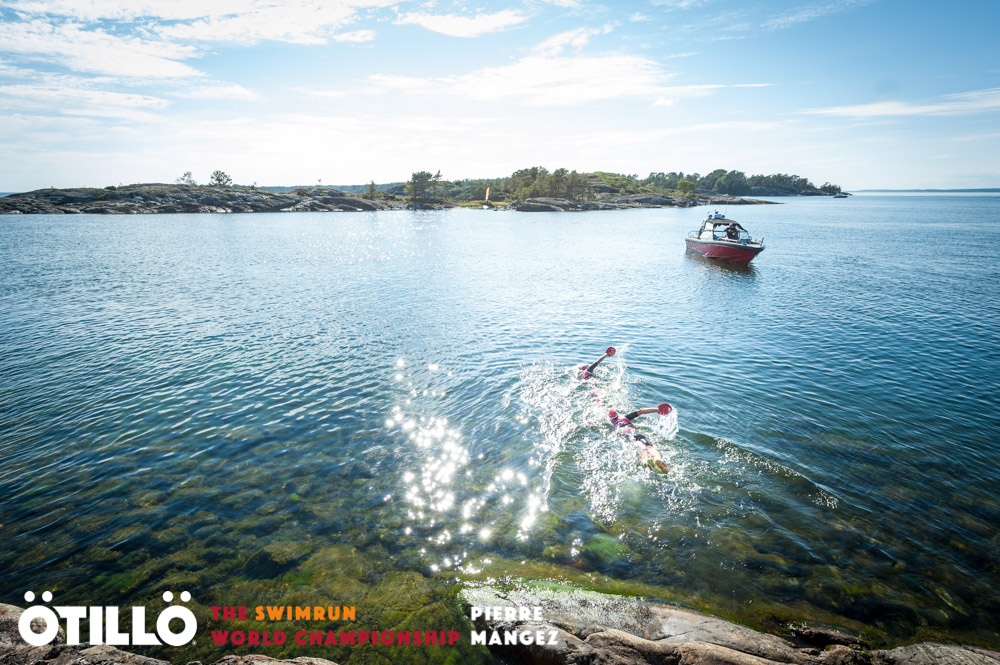
Teamwork
- Leave all pride aside. If the pace is too high for you, let it be known. The other way around, ask your partner if they’ve remembered to take a gel lately. His/her success is your success.
- Equal swimmers will let the more tired runner draft swims to regain some energy for the next run.
- Even if you’ve got equal capacity in all respects, maybe bring a line under the wetsuit in case either of you ends up having a bad day.
- If you are competitive both number one and two are done in-flight. Preferably during a swim or just before, to avoid developing rashes. With a short-legged wetsuit number two can be done quickly. I don’t know why I put this under teamwork.
- Is your partner struggling? Figure out if it may be the heat, nutrition, foggy goggles or whatever — and help fix the problem. ÖTILLÖ is not typically an event that attracts lazy people, so nagging or blaming your partner would likely be misguided.
- The level of competition at Worlds is increasing with every year, but camaraderie between teams is still respectful. Teams overtaking will often give you encouraging words. I think that is a natural when everyone is in a team and a part of this special event.
Gear
Although this and that is allowed, at the sharp end gear has basically consolidated into:
- Pullbuoy with a lot of lift (compared to what pool swimmers are used to). The most popular are probably Ark Keel and Swimrunners Piraya. I use a DIY epoxied double Huub Big Bouy also favoured by some other athletes. Some have seen the guru to get a Rövraket (if you know, you know).
- Wet suit specifically made for swimrun. I use Ark Korp but there are several good options. A pocket is handy to store gel and mandatories. In most weathers short sleeves are enough. Front-end athletes typically prioritize run performance. The bib will mess up your drag anyway and lift you get from the pullbuoy. The wetsuit is basically there to not be in the way and to provide warmth in cold water. I found that in protecting against cold water, it is more important that the wetsuit does not let in too much water than that the neoprene is thick.
- Hand paddles equivalent to Strokemakers. Lighter is better, size according to strength.
- Goggles: light is fast. Slim or even Swedish Goggles.
- Shoes: for this race, think orienteering. VJ Sport’s butyl rubber mix and rock plate shoes are currently in fashion.
- Tow line: roughly half of the front-end use it at Worlds. Some bring just in case.
- In case of extreme cold: neoprene bandana, long sleeves and perhaps even a neoprene vest. Unusual, though.
- Where do you store gel flasks and mandatory first aid? In a sports top or bra, your lower underwear or a pocket if your suit has one. Make sure they don’t bounce around too much or fall out while running.
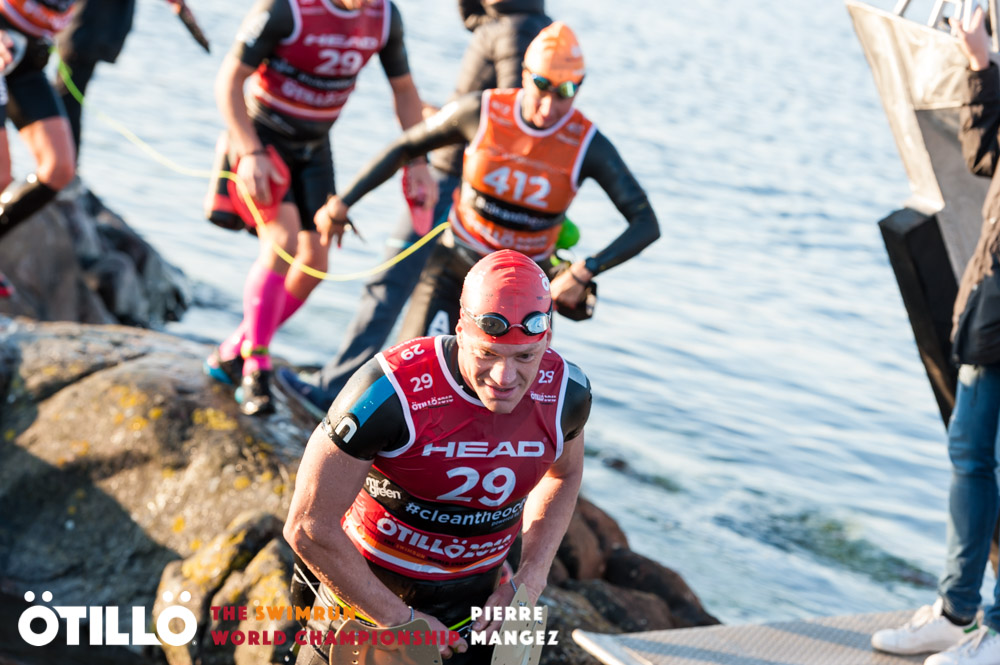
This covers perhaps 20 % of the things that are handy to know. Dissecting this race you will find it is potentially so complex that you can’t expect to perform at your full physical potential the first time entering. Still worth it!
I don’t want to scare anyone from entering and it is not only for the very competitive. ÖTILLÖ World Champs is magical. Rich Roll even went as far as to call it life-defining. The scenery, the spirit among the racers and the staff. All magical, regardless of how serious you are about competing.
Ser att detta är ett år gammalt men fantastiskt att du kan få något så “tråkigt” som tips att bli så här roligt! Tack! (Jag ska inte köra men tipsen är bra och stämmer oavsett längre race)
Gillar också att du fick med Rich Roll. En av mina förebilder alla kategorier!
Stort lycka till!
Tack! Rich Roll är inspirerande!